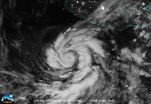Hurricane Blanca now appears less organized in NASA infrared light
2015-06-04
(Press-News.org) One of the instruments that flies aboard NASA's Aqua satellite looks at tropical cyclones using infrared light. In a comparison of infrared data from June 3 and 4, images show that Hurricane Blanca had weakened and became less organized.
The Atmospheric Infrared Sounder or AIRS instrument that flies aboard NASA's Aqua satellite measured cloud top temperatures in Blanca on June 3 at 20:17 UTC (4:23 p.m. EDT) when maximum sustained winds were near 140 mph (220 kph) with higher gusts. At the time, Blanca was a category 4 hurricane on the Saffir-Simpson Hurricane Wind Scale. The AIRS data showed a concentrated ring of powerful thunderstorms around a pinhole eye. Because infrared data measures temperature, AIRS saw that cloud top temperatures in the thunderstorms surrounding the tiny eye were as cold as -81.6F/-63.1C.
When Aqua passed over Blanca the following day, June 4 at 08:36 UTC (4:36 a.m. EDT) AIRS captured more information about the structure and cloud top temperatures. That satellite overpass showed that the bands of thunderstorms spiraling into the center had become fragmented and the pinhole eye that was visible on June 3 had disappeared from the AIRS image on June 4. At the time of the image, Blanca's maximum sustained winds had dropped to 125 mph (205 kph). The 4 a.m. EDT discussion from the National Hurricane Center (NHC) noted "It is not clear whether the slight decrease in wind speed is a result of an eyewall replacement cycle, drier air wrapping into the circulation, or upwelling of cooler waters beneath the nearly stationary hurricane."
At 08:29 UTC (4:29 a.m. EDT), the VIIRS or Visible Infrared Imaging Radiometer Suite (VIIRS) instrument aboard NASA-NOAA's Suomi satellite captured an infrared night-time picture of Hurricane Blanca several hundred miles west of the Mexican coast. The VIIRS image showed what appeared to be a cloud-filled eye and confirmed the bands of thunderstorms wrapping into it had become more fragmented.
On June 4, in the 11 a.m. EDT discussion, the NHC noted that "It appears that the combination of upwelling and an eyewall replacement cycle has resulted in significant weakening of Blanca during the past 18 hours or so. The eye is not as clear as it was yesterday, and the deep convection is no longer symmetric around what is left of the eye."
Blanca is close enough to land to cause dangerous ocean swells. The National Hurricane Center cautioned that swells generated by Blanca will likely affect portions of the coast of southwestern Mexico during the next couple of days. These swells are likely to cause life-threatening surf and rip current conditions.
At 11 a.m. EDT (1500 UTC), the center of Hurricane Blanca was located near latitude 12.3 North, longitude 105.1 West. That places the center of Blanca about 465 miles (750 km) south of Manzanillo, Mexico, and about 795 miles (1,285 km) south-southeast of Cabo San Lucas.
Maximum sustained winds have decreased to near 110 mph (175 kph) with higher gusts. Blanca is moving toward the northwest near 3 mph (6 kph), and this general motion with an increase in forward speed is expected during the next 48 hours.
NHC noted that Blanca is forecast to re-strengthen some during the next 48 hours before starting to weaken again when it runs into increasing shear and cool waters as the storm approaches the Baja California peninsula. For the latest forecast updates, visit: http://www.nhc.noaa.gov.
INFORMATION:
[Attachments] See images for this press release:


ELSE PRESS RELEASES FROM THIS DATE:
2015-06-04
DURHAM, NC -- There aren't any giants or midgets when it comes to the cells in your body, and now Duke University scientists think they know why.
A new study appearing June 3 in Nature shows that a cell's initial size determines how much it will grow before it splits into two.
This finding goes against recent publications suggesting cells always add the same amount of mass, with some random fluctuations, before beginning division.
"It's like students going through college," said Lingchong You, the Paul Ruffin Scarborough Associate Professor of Engineering in the ...
2015-06-04
The most aggressive largemouth bass in the lake are also the ones most prized by anglers. These are the fish that literally 'take the bait' and put the fun into both competitive and casual sport fishing.
Then, according to the rules of catch-and-release, the captive is unhooked and tossed back to swim away without any lasting consequences. But a new UConn study says there is an impact; the evolutionary path of a species may be on the line.
In a recent paper published in the journal PLOS ONE, a team of researchers led by Jan-Michael Hessenauer and Jason Vokoun of the ...
2015-06-04
Armed with new knowledge about how neurodegenerative diseases alter brain structures, increasing numbers of neurologists, psychiatrists and other clinicians are adopting quantitative brain imaging as a tool to measure and help manage cognitive declines in patients. These imaging findings can help spur beneficial lifestyle changes in patients to reduce risk for Alzheimer's disease.
The concept that cognitive decline can be identified early and prevented by applying quantitative brain imaging techniques is the focus of "Hot Topics in Research: Preventive Neuroradiology ...
2015-06-04
ATLANTA - June 4, 2015- Screening for colorectal cancer increased in lower socioeconomic status (SES) individuals after 2008, perhaps reflecting the Affordable Care Act's removal of financial barriers to screening according to a new analysis. The study, by American Cancer Society investigators, appears online in the journal Cancer.
The Patient Protection and Affordable Care Act (ACA) included a cost-sharing provision intended to reduce financial barriers for preventive services, including screening for colorectal cancer (CRC) and breast cancer (BC). To investigate whether ...
2015-06-04
Withholding angiotensin receptor blockers (ARBs) for longer than two days after surgery is associated with a significantly increased risk of postoperative death, according to a study of more than 30,000 patients in the VA health care system by researchers at UC San Francisco and the San Francisco VA Medical Center (SFVAMC).
ARBs are prescribed for high blood pressure, heart disease and kidney disease, explained lead author Susan M. Lee, MD, an SFVAMC anesthesiologist and UCSF clinical instructor.
"For non-cardiac surgery, ARBs are commonly stopped on the day of surgery ...
2015-06-04
Researchers at the University of Tokyo have succeeded in developing a new microscope capable of observing the magnetic sensitivity of photochemical reactions believed to be responsible for the ability of some animals to navigate in the Earth's magnetic field, on a scale small enough to follow these reactions taking place inside sub-cellular structures.
Several species of insects, fish, birds and mammals are believed to be able to detect magnetic fields - an ability known as magnetoreception. For example, birds are able to sense the Earth's magnetic field and use it to ...
2015-06-04
The advent of online social networks has led to the rapid development of tools for understanding the interactions between members of the network, their activity, the connections, the hubs and nodes. But, any relationships between lots of entities, whether users of Facebook and Twitter, bees in a colony, birds in a flock, or the genes and proteins in our bodies can be analyzed with the same tools.
Now, research published in International Journal of Data Mining and Bioinformatics shows how social network analysis can be used to understand and identify the biomarkers in ...
2015-06-04
SEATTLE - Physical activities, such as walking, as well as aerobics/calisthenics, biking, gardening, golfing, running, weight-lifting, and yoga/Pilates are associated with better sleep habits, compared to no activity, according to a new study from researchers at the Perelman School of Medicine at the University of Pennsylvania. In contrast, the study shows that other types of physical activity - such as household and childcare -- work are associated with increased cases of poor sleep habits. The full results of the study (Abstract #0246) will be presented during the poster ...
2015-06-04
ITHACA, N.Y. - A new Cornell study of New York state apple orchards finds that pesticides harm wild bees, and fungicides labeled "safe for bees" also indirectly may threaten native pollinators.
The research, published June 3 in Proceedings of the Royal Society B, finds the negative effects of pesticides on wild bees lessens in proportion to the amount of natural areas near orchards.
Thirty-five percent of global food production benefits from insect pollinators, and U.S. farmers have relied exclusively on European honeybees, whose populations have been in decline for ...
2015-06-04
CINCINNATI - Researchers have identified that parent-reported responses to a questionnaire called the Pediatric Eosinophilic Esophagitis Symptom Score (PEESS® v2.0) correspond to clinical and biologic features of eosinophilic esophagitis (EoE) - a severe and often painful food allergy that renders children unable to eat a wide variety of foods.
This study, published online in Journal of Allergy and Clinical Immunology, was led by researchers at Cincinnati Children's Hospital Medical Center.
Eosinophils are normal cellular components of the blood, but when the body ...
LAST 30 PRESS RELEASES:
[Press-News.org] Hurricane Blanca now appears less organized in NASA infrared light



